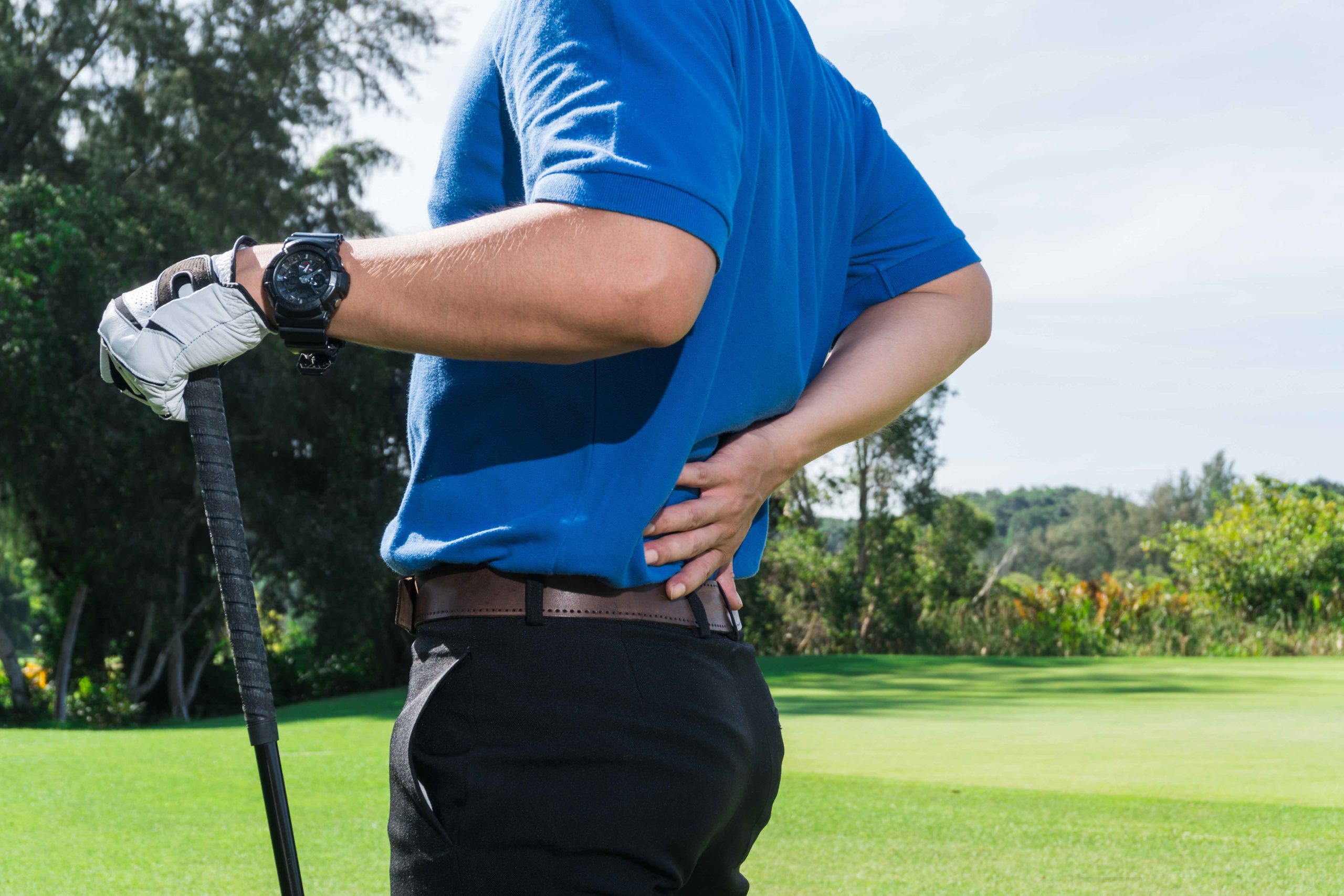Low back pain is extremely common in recreational and professional golfers. Even Tiger Woods has succumbed to multiple back surgeries. It is estimated that 35% of amateur and up to 55% of professional golfers experience significant time lost from golf due to back pain. Swing mechanics, age, frequency of play, and individual physical limitations have been cited as risk factors. Many golfers we work with have limitations in their ability to rotate and bend through their spine and hips. This increases demands and stress to your low back joints, muscles, and discs. You will correct these limitations by doing exercises to improve the mobility of your hips and torso.
The Physical Demands of Golf and Back Pain
The golf swing is a repetitive asymmetrical motion. This predisposes you to strength and mobility imbalances between your right and left sides. In order to optimize your swing mechanics, focus on improving the separation between your shoulders and pelvis. This is beneficial in both the backswing and downswing. However, these large twisting motions are performed at high speeds with high forces. This places substantial loads on your spine joints, discs, and muscles.

Your spine must also laterally bend or tilt at ball impact and follow-through. Furthermore, your spine must bend backward during the follow-through. Many golfers we work with lack mobility to efficiently move into some or all of these positions. Thankfully, many respond quickly to exercises that address their individual limitations. The 5 videos that follow are examples of exercises we prescribe to golfers to improve their hip and spine mobility. Exercises are done as a preventative strategy to avoid future problems. Or do them to alleviate existing back pain impacting your swing and score.
90/90 Hip Stretch
This stretch improves rotation through your hips. Without adequate rotation of your hips, stress to your spine is increased.
To perform the stretch, sit on the floor with your knees bent to 90 degrees. Place one knee in front of your body and the other behind. Place one hand to the outside of your front knee. Your other hand goes in front of your shin. Gently lean forward with a straight back. Hold this position for 3 to 5 seconds then return to the starting position.
Next, walk your hands so one is placed in front of your knee and the other in front of your ankle. Repeat the stretch. Finally, repeat with your hands at mid-shin and to the inside of your foot. At each position, you should feel a stretch deep in your buttock. Perform this stretch 3 to 5 times on each side.
Hip Flexor Self-Mobilization
Limited hip extension flexibility is a common cause of pain during your follow-through. Limited extension stresses the joints of your spine. Performing this self-mobilization with abdominal strengthening exercises alleviates the pain.
Assume a kneeling position. Stay as tall as you can and tighten your stomach muscles. You should experience a mild stretch in the front of your hip in this position. Gently lean in to increase the stretch. Hold the position for 3 to 5 seconds and perform 10 to 20 repetitions.
To increase the stretch, bend your back knee and hold your ankle. If you do this, be sure to maintain the contraction of your stomach muscles and avoid arching through your back.
Thoracic Rotation Self-Mobilization in Standing
This standing rotation exercise is ideal to incorporate into a pre-game warm-up. From a standing semi-squat position place one arm between your thighs just above your knees. This position will block hip and pelvic movement. Most of the movement will now be coming from your upper back.
Next, rotate your body upwards towards the sky by following your open hand with your eyes. At the top of the movement, exhale before returning to the starting position. Perform 10 repetitions and then repeat on the opposite side.
Rotations with Side Bends in Half Kneeling
This exercise helps improve shoulder to pelvis separation. It also helps decrease stress to your spine during ball impact and follow-through.
Assume a half-kneeling position. Place your arms behind your head or across your chest. Rotate your body towards the side of your front leg. While holding the rotation, gently lean your shoulder towards your hip. Return to the upright position and then attempt to rotate a little further. Complete this sequence 2 to 3 times on one side. Then switch sides and repeat with your other knee up. Perform 3 to 5 repetitions on each side.
Rock Backs in Internal Rotation
Many golfers have tightness of their lead hip rotators. This exercise helps improve lead hip internal rotation range of motion.
Assume an all-4’s position with your hips over your knees and shoulders over your hands. Rotate your feet out away from your body and maintain this position throughout the exercise. This will bias the stretch to your hips.
Next, sit back on your heels while keeping your back flat. Movement should be occurring at your hips and shoulders, not your spine. Hold this position 2 to 3 seconds and perform 10 to 20 repetitions.
How to Reduce Your Risk for Golf Injuries
Low back pain in golfers can range from a mild annoyance to debilitating. Regular exercise can alleviate much of the distress and help keep you on the course. In order to achieve the best results, exercises should be performed multiple times each week. Infrequent or random exercise will do you little good. Give these 5 exercises a shot for a few weeks and see how things are going.
If you want more help give us a call. Our physical therapists can help you find the right exercises for you and supplement these with massage and other manual therapy treatments. We offer a free evaluation for golfers looking to feel better and improve their swing. Call us to schedule your golf evaluation.


